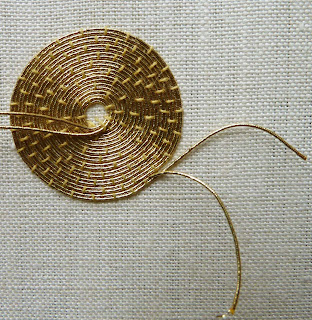I went to a fascinating workshop in Japanese embroidery recently. It was run by
Midori Matsushima, a very experienced Japanese embroiderer.

We used flat silk thread, both in it's pure flat state and also learnt how to twist it (so it looks similar to a
superior perlé thread). The shape on the left is done in satin stitch using twisted thread, and the flat silk on the right (the photo doesn't do justice to the amazing sheen). The knots are Japanese knots - similar to French knots, but the technique is slightly different (and, given the state of some of my efforts,
much more difficult). The final thing we tried was using fine gold thread. Sewing with the gold was easier than I'd expected, and beautifully rewarding.

One of the lovely things about the workshop was using different tools: an awl, a minimalist pair of scissors and a small, slightly chunky needle with a round, rather than flat, eye (shown next to a size 10 embroidery needle). Apparently the round eye puts less strain on the delicate silk than a flat eye, and the small needle was actually easy to use.

The whole experience was great, an intriguing insight into a different way of stitching led by a real expert.
 First day was using detached buttonhole stitch to attach small objects to fabric. I've never been totally sure of the difference between buttonhole stitch and blanket stitch, but it seems that standard buttonhole is just blanket stitch with the stitches close together (although there are variations on buttonhole which are more complex). Buttonhole certainly sounds more complex and professional, not least as blanket stitch is often one of the first stitches taught to children - I distinctly remember the blue felt recorder case I blanket-stitched in junior school.
First day was using detached buttonhole stitch to attach small objects to fabric. I've never been totally sure of the difference between buttonhole stitch and blanket stitch, but it seems that standard buttonhole is just blanket stitch with the stitches close together (although there are variations on buttonhole which are more complex). Buttonhole certainly sounds more complex and professional, not least as blanket stitch is often one of the first stitches taught to children - I distinctly remember the blue felt recorder case I blanket-stitched in junior school. For our purposes, the coins were covered in silk organza stab stitched to hold the coin in place whilst the buttonhole was stitched (the idea is that the stitching eventually holds the coin firmly enough that the organza can be shredded and pulled away). The first row of buttonhole was stitched very closely to the edge of the coin, and then subsequent rows were stitched into the previous row (this is the 'detached' element, the stitching is detached from the fabric, as distinct from e.g. detached chain stitch where the stitch is detached from the other stitches).
For our purposes, the coins were covered in silk organza stab stitched to hold the coin in place whilst the buttonhole was stitched (the idea is that the stitching eventually holds the coin firmly enough that the organza can be shredded and pulled away). The first row of buttonhole was stitched very closely to the edge of the coin, and then subsequent rows were stitched into the previous row (this is the 'detached' element, the stitching is detached from the fabric, as distinct from e.g. detached chain stitch where the stitch is detached from the other stitches). 














